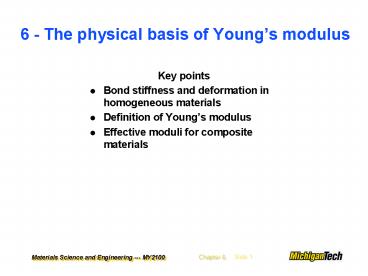6 The physical basis of Youngs modulus - PowerPoint PPT Presentation
1 / 11
Title:
6 The physical basis of Youngs modulus
Description:
Bond stiffness and deformation in homogeneous materials. Definition of ... Effective moduli for composite materials. Materials Science and ... order of ... – PowerPoint PPT presentation
Number of Views:414
Avg rating:3.0/5.0
Title: 6 The physical basis of Youngs modulus
1
6 - The physical basis of Youngs modulus
- Key points
- Bond stiffness and deformation in homogeneous
materials - Definition of Youngs modulus
- Effective moduli for composite materials
2
Youngs modulus reflects the bond stiffness and
area density of bonds
For a spring F - k x
3
Estimating Youngs Modulus(The Math)
4
For an ionic material
5
Hierarchy of bond stiffnesses
6
Factors Governing Moduli in Lightly Cross Linked
Polymers (e.g. rubber) are Different from those
in Crystalline Materials
- At low temperatures, polymers behave more or less
as expected - 2 Gpa lt E lt 4 GPa
- At higher temperatures, the moduli can be much
lower than predicted on the basis of Van der
Waals bonding - On the order of 10-2 GPa
- At these temperatures, Van der Waals bonds
melt, and E is governed by much lower stresses
required to untangle individual polymer chains - Strong covalent cross linking keeps the overall
structure from melting, the doesnt contribute
much to the modulus
7
The Temperature at which Van der Waals Bonds
Melt is called the Glass Transition
Temperature, TG
- Polymers with no cross linking become viscous
liquids above TG - Those with some cross linking become leathery
- Highly cross-linked polymers have moduli
comparable to aluminum
8
Composites Allow Materials Engineers to Tailor
Properties
Particle Reinforced
Fiber Reinforced
Laminar (Layered)
9
Fiber Reinforced CompositesLoaded Parallel to
the Fibers
Upper Limit
We assume that the longitudinal strain in the
fibers and the matrix are the same
10
Fiber Reinforced CompositesLoaded Normal to the
Fibers
Lower Limit
We assume that the stresses in the fibers and the
matrix are the same
s
11
Other Composites Have Moduli That Fall Between
the Upper and Lower Limits for Fibrous Composites
- Particulate composites have moduli that are near
the lower limit - isotropic































